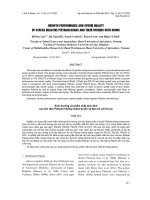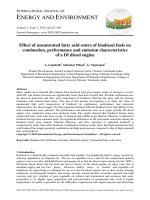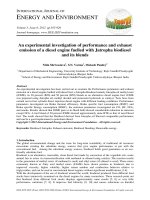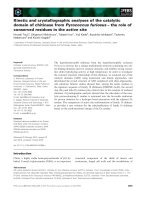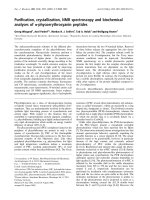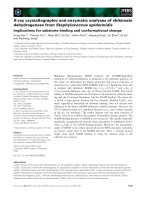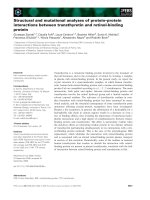Performance and complexity analyses of h 264 AVC CABAC entropy coder
Bạn đang xem bản rút gọn của tài liệu. Xem và tải ngay bản đầy đủ của tài liệu tại đây (673.49 KB, 123 trang )
PERFORMANCE AND COMPLEXITY ANALYSES OF
H.264/AVC CABAC ENTROPY CODER
Ho Boon Leng
(B.Eng (Hons),NUS)
A THESIS SUBMITTED
FOR THE DEGREE OF MASTER OF ENGINEERING
DEPARTMENT OF ELECTRICAL AND
COMPUTER ENGINEERING
NATIONAL UNIVERSITY OF SINGAPORE
2006
ACKNOWLEDGEMENTS
I would like to dedicate this thesis to my family, especially my parents. The
journey to obtain the master degree has been tough and I am extremely grateful for
their understanding and constant support.
I would also like to express my gratitude to my supervisor, Dr Le Minh Thinh
for his patience, guidance, and advice in my research. He has provided constructive
suggestions and recommendations for my research work.
I would also like to express my sincere thanks to my colleagues, Tian Xiaohua
and Sun Xiaoxin for all the helps they have given me throughout my research work
Last but not least, I would like to express my utmost appreciations to my good
friends, Ong Boon Kar and Cheong Kiat Fah for always having been there for me.
i
TABLE OF CONTENTS
Acknowledgements.............................................................................................i
Table of Contents...............................................................................................ii
List of Tables ....................................................................................................iv
List of Figures ..................................................................................................vii
List of Figures ..................................................................................................vii
List of Symbols .................................................................................................ix
Abstract ..............................................................................................................x
Chapter 1
Introduction....................................................................................1
1.1
Research Work...................................................................................2
1.2
Motivation..........................................................................................2
1.3
Thesis Contributions ..........................................................................4
1.4
Thesis Organization ...........................................................................4
Chapter 2
Background ....................................................................................6
2.1
Entropy coder.....................................................................................6
2.2
Overview of CABAC.........................................................................6
2.3
Encoder Control ...............................................................................10
2.4
Complexity Analysis Methodologies...............................................11
2.5
Existing Works.................................................................................15
2.6
Conclusion .......................................................................................17
Chapter 3
Performance Analyses of Entropy Coding Schemes ...................19
3.1
Introduction......................................................................................19
3.2
Performance Metrics........................................................................20
3.3
Implementation ................................................................................20
ii
3.4
Test Bench Definitions ....................................................................21
3.5
Performance Analyses .....................................................................23
3.6
Conclusion .......................................................................................28
Chapter 4
Complexity Analyses ...................................................................30
4.1
Introduction......................................................................................30
4.2
Complexity Metric Definitions ........................................................31
4.3
Computational Complexity..............................................................31
4.4
Data Transfer Complexity................................................................40
4.5
Memory Usage.................................................................................49
4.6
Functional Sub-blocks and ISA classes Analyses ...........................51
4.7
Performance-Complexity Co-evaluation of CABAC ......................55
4.8
Conclusions......................................................................................58
Chapter 5
RDO for Mode Decision..............................................................61
5.1
Predictive Coding Modes.................................................................61
5.2
Fast RDO .........................................................................................69
5.2
Conclusion .......................................................................................75
Chapter 6
Conclusions..................................................................................77
6.1
Findings............................................................................................77
6.2
Suggestions / Recommendations .....................................................81
Bibliography ....................................................................................................84
Appendices.......................................................................................................88
A1:
Instruction Set Architecture Class ...................................................88
A2:
ISA Classification for CIF Foreman ................................................89
A3:
Pin Tools Program Codes ................................................................95
iii
LIST OF TABLES
Table 3-1: Test sequences and their motion content classification..............................21
Table 3-2: Encoder configuration cases.......................................................................22
Table 3-3: Percentage Bit-rate Savings Due to CABAC .............................................23
Table 3-4: Percentage Bit-rate Savings by RDO .........................................................24
Table 3-5: Overall bit-rate savings in percentage ........................................................26
Table 3-6a: ∆ Y-PSNR due to CABAC in a non-RDO encoder at different constant
bit-rates........................................................................................................28
Table 4-1: Percentage increase in computational complexity of the entropy coder due
to CABAC...................................................................................................32
Table 4-2: Computational complexity of CABAC entropy coder in a non-RDO
encoder and a RDO encoder .......................................................................33
Table 4-3: Computational complexities of entropy coder in different combinations of
entropy coding schemes and configurations for non-RDO and RDO
encoders ......................................................................................................35
Table 4-4: Computational complexities of the non-RDO encoder and the RDO
encoder using different combinations of entropy coding schemes and
configurations..............................................................................................36
Table 4-5: Percentage increase in computational complexity of the RDO encoder due
to CABAC...................................................................................................38
Table 4-6: Percentage reduction in computational complexity of the video decoder
due to CABAC ............................................................................................39
Table 4-7: Percentage increase in data transfer complexity of the entropy coder due to
CABAC .......................................................................................................40
iv
Table 4-8: Data transfer complexity of CABAC entropy coder in a non-RDO encoder
and an RDO encoder ...................................................................................42
Table 4-9: Data transfer complexities of entropy coder in different combinations of
entropy coding schemes and configurations for non-RDO and RDO
encoders ......................................................................................................43
Table 4-10: Data transfer complexities of the non-RDO encoder and the RDO encoder
using different combinations of entropy coding schemes and configurations
.....................................................................................................................45
Table 4-11: Percentage increase in the data transfer complexity of the RDO encoder
due to CABAC ............................................................................................46
Table 4-12: Reduction in average memory access by the RDO encoder per GOP due
to 16KB L1 data cache................................................................................48
Table 4-13: Percentage reduction in data transfer complexity of the video decoder due
to CABAC...................................................................................................49
Table 4-14: Performance-complexity table .................................................................56
Table 5-1: Performance degradation and complexity reduction in the RDO encoder
due to disabling Intra 4x4 directional modes for Main profile configuration
with CABAC...............................................................................................64
Table 5-2: Bit-rate savings by CABAC for the RDO encoder and the suboptimal-RDO
encoder ........................................................................................................68
Table 5-3: Ordering of prediction modes for the fast-RDO encoder...........................70
Table 5-4a: Percentage bit-rate savings due to fast-RDO encoder ..............................71
Table 5-5: Percentage change in computational complexity of the video encoder due
to fast-RDO in comparison to a non-RDO encoder ....................................74
v
Table 5-6: Percentage increase in data transfer complexity of the video encoder due to
fast-RDO in comparison to a non-RDO encoder ........................................75
Table 6-1: Real-time computational and memory requirements of CABAC entropy
coder............................................................................................................77
vi
LIST OF FIGURES
Figure 2.1: CABAC entropy coder block diagram ........................................................7
Figure 4.1: Instruction set architecture of entropy instruction executed by the CABAC
entropy coder...............................................................................................50
Figure 4.2: Functional sub-blocks diagram of the CABAC entropy coder .................52
Figure 4.3: Percentage breakdown of entropy coding computation based on functional
sub-blocks of CABAC entropy coder in a RDO encoder with Main profile
configuration ...............................................................................................53
Figure 4.4: Percentage of ISA classes for the executed entropy instructions in a RDO
encoder ........................................................................................................54
Figure 5.1: Percentage of prediction modes used in encoding QCIF and CIF
sequences ....................................................................................................62
Figure 5.2: Partitioning of entropy instructions based on predictive coding modes in
the RDO encoder.........................................................................................63
Figure 5.3: Percentage increments in computational complexity of the RDO encoder
and the suboptimal-RDO encoder due to the use of CABAC for (a) QCIF
sequences (b) CIF sequences ......................................................................66
Figure 5.4: Percentage increments in data transfer complexity of the RDO encoder
and the suboptimal-RDO encoder due to the use of CABAC for (a) QCIF
sequences (b) CIF sequences ......................................................................67
Figure 5.5: Computational complexity of the fast-RDO encoder and the non-RDO
encoder for test sequence Akiyo ..................................................................72
Figure 5.6: Computational complexity of the fast-RDO encoder and the non-RDO
encoder for test sequence Mother & Daughter ...........................................73
vii
Figure 5.7: Computational complexity of the fast-RDO encoder and the non-RDO
encoder for test sequence Silent ..................................................................73
Figure 5.8: Computational complexity of the fast-RDO encoder and the non-RDO
encoder for test sequence Paris...................................................................74
viii
LIST OF SYMBOLS
B&CM
Binarization & Context Modeling
CABAC
Context Adaptive Binary Arithmetic Coding
CAVLC
Context Adaptive Variable Length Coding
CIF
Common Intermediate Format
FMS
Finite Machine State
GOP
Group of Pictures
IS
Interval Subdivision
ISA
Instruction Set Architecture
LPS
Least Probable Symbol
MPEG
Moving Picture Expert Group
MPS
Most Probable Symbol
NRDSE
Non-residual Data Syntax Element
QCIF
Quarter Common Intermediate Format
RDO
Rate Distortion Optimization
RDSE
Residual Data Syntax Element
Y-PSNR
Luma Peak Signal-to-Noise Ratio
ix
ABSTRACT
Context Adaptive Binary Arithmetic Coding (CABAC) is one of the entropy
coding schemes defined in H.264/AVC. In this work, the coding efficiency, the
computational and memory requirements of CABAC are comprehensively assessed
for the different type of video encoders. The main contributions of the thesis are the
reported findings from the performance and complexity analyses. These findings
assist implementers in deciding when to use CABAC for a cost-effective realization
of the video codec that meets their system’s computational and memory resources.
Bottlenecks in CABAC have also been identified and recommendations on possible
complexity reductions have been proposed to system designers and software
developers.
CABAC is more complex than Context Adaptive Variable Length Coding
(CAVLC), and is dominated by data transfer in comparison to arithmetic and logic
operations. However, it is found that the use of CABAC is only resource expensive
when Rate-Distortion Optimization (RDO) is employed. For a RDO encoder, CABAC
hardware accelerator will be needed if the real-time requirement is met. Alternatively,
the use of suboptimal RDO techniques can reduce the computational and memory
requirements of CABAC on the video encoder, making it less expensive to use
CABAC in comparison to CAVLC.
x
CHAPTER 1
INTRODUCTION
Over the past decade, digital video compression technology has evolved
tremendously, which made possible many application scenarios from video storage to
video broadcast and streaming over Internet and telecommunication networks. The
aim of video compression is to represent the video data with the lowest bit-rate at a
specified level of reproduction fidelity, or to represent the video data at the highest
reproduction fidelity with a given bit-rate.
H.264/AVC [1] is the latest international video compression standard. In
comparison to the previous video compression standards such as MPEG-4 [2] and
H.263 [3], it provides higher coding performance and better error resilience through
the use of improved or new coding tools at different stages of the video coding. For
the entropy coding stage, H.264/AVC offers two new schemes for coding its
macroblock-level syntax elements: Context Adaptive Variable Length Coding
(CAVLC) and Context Adaptive Binary Arithmetic Coding (CABAC). Both entropy
coding schemes achieve better coding efficiency than their predecessors in the earlier
standards as they employed context-conditional probability estimates. Comparatively,
CABAC performs better than CAVLC in terms of coding efficiency as it encodes data
with non-integer length codeword, and it adjusts its context-conditional probability
estimates to adapt to the non-stationary source statistics. However, the higher coding
efficiency of CABAC comes at the expense of increased complexity in the entropy
coder. This is one of the reasons why the developer team of H.264/AVC excludes
CABAC from the Baseline profile [5].
1
1.1
Research Work
In this work, comprehensive performance and complexity analyses of CABAC
at both the entropy coder level and the video encoder/decoder levels will be
conducted using software verification model. Both variable bit-rate video encoder and
constant bit-rate video encoder will be considered. For the performance analyses,
percentage bit-rate savings and changes in peak signal-to-noise ratio of the video
luminance component (Y-PSNR) will be used. As for the complexity analyses,
computational complexity, data transfer complexity and memory usage will be
assessed. The goals of the analyses are:
(a) To present the computational and memory requirements of CABAC
(b) To identify “scenarios” where the use of CABAC is more cost-effective
based on a co-evaluation of the system’s coding efficiency and complexity
performance across different configurations and encoder types.
(c) To identify the possible bottlenecks in the CABAC entropy coder and to
make possible recommendations / suggestions on complexity reduction of
CABAC to system designers or software developers.
1.2
Motivation
The CABAC tool is not supported in the Baseline profile of H.264/AVC. As
such, it is commonly believed that using CABAC is computationally expensive for a
video encoder. However, no work has been done on evaluating the complexity
requirements of using CABAC except in [4], which gives a brief assessment of the
effect of using CABAC on the video encoder’s data transfer complexity. (More
2
details on the related works that have been carried out for H.264/AVC are given in
Chapter 2.)
In [4], the additional memory requirement of using CABAC over CALVC
from the perspective of the video encoder is briefly reported, and this result has been
referenced by many literatures (due to the lack of works done in this area). However,
the complexity evaluation of CABAC given in their work is far from being complete,
as it performs a tool-by-tool add-on analysis, and CABAC is only considered for one
specific encoder configuration. Moreover, it also failed to include any complexity
analyses of using CABAC at the decoder.
There are also some drawbacks in evaluating the complexity increment of
using CABAC over CAVLC from the perspective of the video encoder. The results
can be misleading as these complexity figures also depend on the choices of coding
tools used in the video encoder. This makes comparison of such figures across
different configurations less meaningful. Besides, analyzing the complexity
performance of CABAC from the perspective of the video encoder will be more of
interest to implementers, who wish to achieve a cost-effective realization of the video
codec. However, it may be less relevant for system designers of CABAC as the
complexity figures do not reflect the true requirements of the entropy coder. Rather,
they will be more interested in the complexity performance of CABAC from the
perspective of the entropy coder.
As such, these provide the motivation for comprehensive analyses on the
performance and complexity of CABAC at two levels: top-level video encoder and
the entropy coder level. It is believed that analyses at the entropy coder level will be
useful to system designers or software developers in understanding the CABAC
3
system properties, to gauge its implementation cost and for optimizing it design
implementation.
1.3
Thesis Contributions
The thesis contributions have been four-fold:
(a)
provided inputs - findings from co-evaluation of performancecomplexity analyses of CABAC -
that can assist implementer in
deciding whether to use CABAC in the video encoder,
(b) identified
possible
bottlenecks
in
CABAC
and
suggests
recommendations on complexity reduction to system designer and
software developers,
(c)
identified when the use of CABAC hardware accelerator may not be
necessarily helpful in the video encoder, and
(d) developed a set of profiler tools based on Pin [13] for measuring
instruction-level complexity and memory access frequency of any
functional coding block of H.264/AVC that can also be used on other
video codec.
1.4
Thesis Organization
The contents in this thesis are organized as follows. In Chapter 2, an overview
of Context Adaptive Binary Arithmetic Coding (CABAC), a review of the complexity
analysis methodologies that have been used for video multimedia system, and a
literature review of existing works will be given. In Chapter 3, the performance of the
CABAC, benchmarked against CAVLC is given for the different video configurations
4
so as to explore the inter-tool dependencies. In Chapter 4, the complexity analyses of
using CABAC at both the entropy coder level and the video encoder/decoder levels
are given. Related research work on rate-distortion optimization (RDO) extending
from the complexity analyses of CABAC are given in Chapter 5. Finally, conclusions
are given in Chapter 6.
5
CHAPTER 2
BACKGROUND
In this chapter, the role of the entropy coder is discussed and an overview of
CABAC is given. This is followed by presenting the different encoder controls that
can be used in the video encoder. Lastly, a review of the complexity analysis
methodologies that have been used for video multimedia system, and a literature
review of existing works will be given.
2.1
Entropy coder
The entropy coder may serve up to two roles in a H.264/AVC video encoder.
The primary role of the entropy coder is to generate the compressed bitstream of the
video file for transmission or storage. For video encoders that optimize its mode
decision using rate-distortion optimization (RDO), its entropy coder performs an
additional role during the mode selection stage. The entropy coder computes the bitrates needed by each candidate prediction mode. The computed rate of information is
then used to guide the mode selection. Further details are given in sub-section 2.3.2.
2.2
Overview of CABAC
Context Adaptive Binary Arithmetic Coding (CABAC) [5] is one of the
entropy coding schemes in H.264/AVC, and is only supported in the Main profile.
Fig. 2.1 shows the block diagram for encoding and decoding a single syntax element
in CABAC.
6
Binarizer
Context
Modeler
Regular
Arithmetic
Coding
Engine
Bypass
Arithmetic
Coding Engine
Encoder
De-binarizer
Regular
Arithmetic
Decoding
Engine
Bitstream
syntax
element
Context
Modeler
syntax
element
Decoder
Bypass
Arithmetic
Decoding Engine
Figure 2.1: CABAC entropy coder block diagram
The encoding/decoding process using CABAC comprises of three stages:
binarization, context modeling, and binary arithmetic coding.
2.2.1 Binarization
The binarization stage maps all non-binary syntax elements into a binary
sequence known as bin-string using four basic binarization schemes: Unary (U),
Truncated Unary (TU), kth order Exp-Golomb (EGK) and Fixed Length (FL). The
only exception where these binarization schemes are not used is when encoding the
macroblock type and the sub-macroblock type syntax elements. For these syntax
elements, unstructured binary trees are used instead of binarization.
7
2.2.2 Context Modeling
Each bin in a bin string is encoded in either normal mode or bypass mode
depending on the semantic of the syntax. For a bypass bin, the context modeling stage
is skipped because a fixed probability model is always used. On the other hand, each
normal bin selects a probability model based on its context from a specified set of
probability models in the context modeling stage. In total, 398 probability models are
used for all syntax elements.
There are four types of context. The type of context used by each normal bin
for selecting the best probability model depends on the syntax element that is
encoded. The first type of context considers the related bin values in its neighboring
macroblocks or sub-blocks. The second type considers the values of the prior coded
bins of the bin-string. These two types of contexts are only used for non-residual data
syntax elements (NRDSE). The last two types of context are only used for residual
data syntax elements (RDSE). One of them considers the position of the syntax
element in the scanning path of the macroblock while the other evaluates a count of
non-zero encoded levels with respect to a given threshold level.
2.2.3 Arithmetic Coding
In the binary arithmetic coding (BAC) stage, the bins are arithmetic coded.
Binary arithmetic coding is based on the principle of recursive sub-division of an
interval length as follows:
E LPS = PLPS ⋅ E
(2-1)
EMPS = E − ELPS
(2-2)
LLPS = L + E − E LPS
(2-3)
LMPS = L
(2-4)
8
where E denotes the current interval length, L denotes the current lower bound of E,
PLPS denotes the probability of least probable symbol (LPS) from the selected
probability model. ELPS and EMPS denote the new lengths of the partitioned intervals
corresponding to LPS and the most probable symbol (MPS). LLPS and LMPS denote the
corresponding lower bounds of the partitioned intervals. For each bin, the current
interval is first partition into two as given in Eqn. 2-1 to Eqn. 2-4. The bin value is
then encoded by selecting the newly partitioned length that corresponds to the bin
value (either LPS or MPS) as the new current interval. E and L are also referred as the
coding states of the arithmetic coder.
In H.264/AVC, the multiplication operation of interval subdivision in Eqn. 2-1
is replaced by using finite state machine (FSM) with a look-up table of pre-computed
intervals as follows:
E LPS = RangeTable[ PˆLPS ][ Eˆ ]
(2-5)
The FSM consists of 64 probability states, PˆLPS and 4 interval states, Eˆ . For the
normal bins, the selected conditional probability model is updated with the new
statistic after the bin value is encoded.
2.2.4
Renormalization
To prevent underflow, H.264/AVC performs a renormalization operation
when the current interval length, E falls below a specified interval length after coding
a bin. This is a recursive operation which resizes the interval length through scaling
until the current interval exceeds the specified interval length. The codeword is output
on the fly each time bits are available after the scaling operation.
9
2.3
Encoder Control
The encoder control refers to the strategy used by the encoder in selecting the
optimal prediction mode to encode each macroblock. In H.264/AVC, the encoder can
select from up to 11 prediction modes: 2 Intra prediction modes and 9 Inter prediction
mode, including SKIP and DIRECT modes to encode a macroblock. Note that the
encoder control is a non-normative part of the H.264/AVC standard. Several encoder
controls have been proposed and are reviewed below.
2.3.1 Non-RDO encoder
For a non-RDO encoder, either the sum of absolute difference (SAD) or the
sum of absolute transform difference (SATD) can be used as the selection criteria.
The optimal prediction mode selected to encode the macroblock corresponds to the
prediction mode that minimizes the macroblock residual signal, i.e. the minimum
SAD or SATD value.
2.3.2
RDO encoder
For a RDO encoder, a rate-distortion cost function is used as the selection
criteria for the optimal mode and is given as
J = D + λR
(2-6)
where J is the rate-distortion cost, D the distortion measure, λ the Lagrange
multiplier, and R the bit-rate. The optimal prediction mode used to encode the
macroblock corresponds to the prediction mode that yields the least rate-distortion
cost. Note that to obtain the bit-rate, entropy coding has to be performed for each
candidature mode. This significantly increases the amount of entropy coding
performed in the video encoder.
10
2.3.3. Fast-RDO encoder
The fast-RDO encoder employs the fast RDO algorithm proposed in [23].
Similar to the RDO encoder, it uses the rate-distortion cost function in Eqn. 2-4 as the
selection criteria. However, it does not perform an “exhaustive” search through all
candidate prediction modes. Rather, it terminates the search process once the ratedistortion cost of a candidate prediction mode lies within a threshold - a value derived
from the rate-distortion cost of the co-located macroblock in the previous encoded
frame. The current candidate prediction mode whose rate-distortion cost lies within
the threshold is selected as the optimal prediction mode, and the remaining prediction
modes are bypassed. If none of the prediction modes meets the early termination
criteria, the prediction mode with the least rate-distortion cost is then selected as the
optimal prediction mode.
2.4
Complexity Analysis Methodologies
In this section, a review of the known complexity analysis methodologies is
given. Complexity analyses are often carried out using verification models software
(in the case of video standards) such as the Verification Model (VM) and the Joint
Model (JM) reference software implementations for MPEG-4 and H.264/AVC,
respectively. These are un-optimized reference implementations but are sufficient for
analyzing the critical blocks in the algorithm for optimization and discovering the
bottlenecks. On the other hand, optimized source codes are needed or preferred for
complexity evaluation when performing hardware / software partitioning as in [6] or
when comparing the performance-complexity between video codec as in [7].
11
2.4.1
Static Code Analysis
Static code analysis is one way of evaluating the computational complexity of
an algorithm, a program or a system. Such analysis requires the availability of the
high-level language source code such as the C codes of the Joint Model (JM)
reference software of H.264/AVC. The methods based on such analysis includes
counting the number of lines-of-code (LOC), counting the number of arithmetic and
logical operations, determining the time complexity of the algorithms, and
determining the lower or upper bound running time of the program by explicit or
implicit enumeration of program paths [8]. Such analyses measure the algorithm’s
efficiency but do not take into considerations the different input data statistics. In
order to obtain an accurate static analysis, restricted programming style such as
absence of recursion, dynamic data structure and bounded loop are needed so that the
maximal time spent in any part of the program can be calculated.
2.4.2 Run-time Computational Complexity Analysis
For run-time complexity analysis, profiling data are collected when the
program executes at run time on a given specific architecture. The advantage of runtime complexity analysis is that input data dependency is also included. One method
of run-time computational complexity analysis is to measure the execution time of the
program using ANSI C clock function [9]. An alternative is to measure the execution
time of the program in terms of clock cycles using tools like Intel VTune - an
automated performance analyzer, or PAPI - a tool that allows access to the
performance hardware counters of the processor for measuring clock cycle [10].
Function-level information can also be collected for coarse complexity
evaluation using profilers such as Visual Studio Environment Profiling Tool or Gprof
12
[11]. These profiling tools provide information on function call frequency and the
total execution time spent by each function in the program. This information allows
identifying the critical functions for optimization and help partial redesign of the
program to reduce the number of function calls to costly functions.
On a finer granularity, instruction level profiling can be carried out to provide
the number and the type of processor instructions that are executed by the program at
run-time. This can be used for performance tuning of program and to achieve more
accurate complexity evaluation. However, the profiling data gathered is dependent on
the hardware platform and the optimization level of the compiler. Unfortunately, there
are few tools assisting this level of profiling. In [12], a simulator and profiler tool set
based on SimpleScalar framework [22] was developed to measure the instruction
level complexity. In our work, a set of profiler tools using Pin was developed to
measure the instruction level complexity of the video codec [13].
2.4.3
Data Transfer and Storage Complexity Analysis
Data transfer and storage operations are other areas where complexity of the
program can be evaluated. Such analyses are essential for data-dominant applications
such as video multimedia applications where it has been shown that the amount of
data transfer and storage operations are at least of the same order of magnitude as the
amount of arithmetic operations [14]. For such application, data transfer and storage
will have a dominant impact on the efficiency of the system realization.
Data transfer and storage complexity analyses have been performed for a
MPEG 4 (natural) video decoder in [14] and H.264/AVC encoder/decoder in [4] using
ATOMIUM [21], an automated tool. This tool measures the memory access
frequency (the total number of data transfers from and to memory per second) and the
13
peak memory usage (the maximum amount of memory that is allocated by the source
code) of the running program. Such analysis allows identifying memory related
hotspots in the program, and optimization of the storage bandwidth and the storage
size. However, the drawback of this tool is that it uses a “flat memory architectural
mode”, and does not consider other memory hierarchy such as one or more levels of
caches.
2.4.4 Platform Dependent /Independent Analysis
Generally, two types of complexity analyses can be performed: platform
dependent complexity analysis and platform independent complexity analysis. The
complexity evaluation using automated tools like VTune and Pin are platform
dependent, specifically for general purpose CISC processor such as Pentium III and
PentiumIV.
Platform independent analysis is generally preferred compared to platform
dependent analysis as the target architecture on which the system will be realized is
most likely different from that used to compile and run the reference implementation.
Tools such as ATOMIUM and SIT [15] are developed with such a goal: to measure
the complexity of a specific implementation of an algorithm independent from the
architecture that is used to run the reference implementation. Besides these tools, a
complexity evaluation methodology for video applications that is platform
independent is also proposed in [16]. In its methodology, the platform-independent
complexity metric used is the execution frequencies of core tasks executed in the
program and is combined with the platform-dependent complexity data (e.g. the
execution time of each core task on different processing platforms) for deriving the
system complexity on various platforms. However, this approach requires
14
